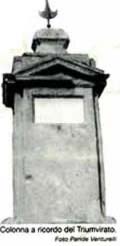 The history of Calderara di Reno is characterized by two rivers that run through the territory. They are the Reno and the Lavino rivers, which have influenced the development and life of the community. Until now the exact place where the historical meeting between Octavianus, Anthony and Lepidus happened in 43 B.C. to establish the tripartition of the Roman Empire, has not been located. There are many suppositions in relation to this event, which are endorsed by a few historians that consider Sacerno, a hamlet of Calderara di Reno, the place of the meeting. Today it is quite impossible to identify the exact place, after all the transformations that occurred in the area. But scene of the meeting was this territory. During the Roman Empire, the Reno river used to run through marshes separated from the river by emerging strips of land, which separated waters. Roman streets ran on these lands: “Via Emilia” and “Via Claudia”. During the XI century these lands were mentioned and were called Polesino da Mattino, presently called Trebbo di Reno, and Polesino di Sera, which is now Longara.
The history of Calderara di Reno is characterized by two rivers that run through the territory. They are the Reno and the Lavino rivers, which have influenced the development and life of the community. Until now the exact place where the historical meeting between Octavianus, Anthony and Lepidus happened in 43 B.C. to establish the tripartition of the Roman Empire, has not been located. There are many suppositions in relation to this event, which are endorsed by a few historians that consider Sacerno, a hamlet of Calderara di Reno, the place of the meeting. Today it is quite impossible to identify the exact place, after all the transformations that occurred in the area. But scene of the meeting was this territory. During the Roman Empire, the Reno river used to run through marshes separated from the river by emerging strips of land, which separated waters. Roman streets ran on these lands: “Via Emilia” and “Via Claudia”. During the XI century these lands were mentioned and were called Polesino da Mattino, presently called Trebbo di Reno, and Polesino di Sera, which is now Longara.
 The first reclamation works were carried out by various religious communities, first of all by the Benedictines originating from Montecassino, during the VIII century. In 1300 the Sant’Elena monastery, that had been abandoned for a long time was taken over by the Servite congregation. The historical events of Calderara were then recorded together with those of Borgo Panigale, the village to which it was united. After the activities of religious communities that took care of convents and monasteries the territory saw another change. The first villas and palaces were built as resorts for nobles of Bologna during the XVI century. This new settlement of nobles was beneficial to the land since lands were salvaged and new land reclamation took place. New land properties were therefore created. Winegrowing was given great attention, since people understood the peculiar value of these lands.
The first reclamation works were carried out by various religious communities, first of all by the Benedictines originating from Montecassino, during the VIII century. In 1300 the Sant’Elena monastery, that had been abandoned for a long time was taken over by the Servite congregation. The historical events of Calderara were then recorded together with those of Borgo Panigale, the village to which it was united. After the activities of religious communities that took care of convents and monasteries the territory saw another change. The first villas and palaces were built as resorts for nobles of Bologna during the XVI century. This new settlement of nobles was beneficial to the land since lands were salvaged and new land reclamation took place. New land properties were therefore created. Winegrowing was given great attention, since people understood the peculiar value of these lands.